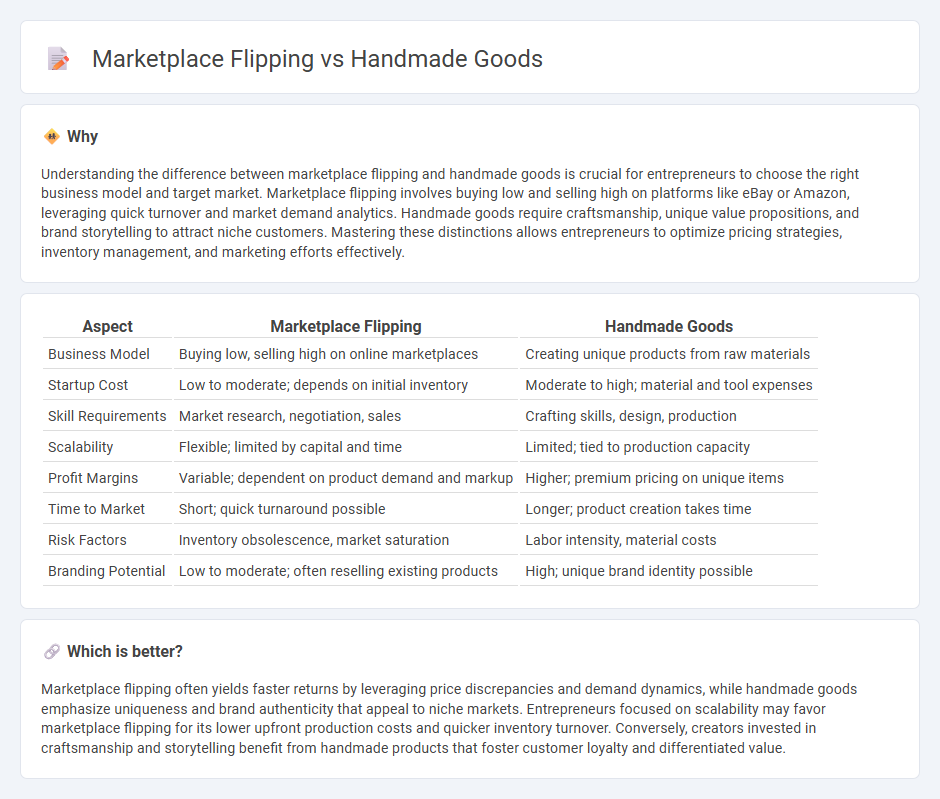
Marketplace flipping involves purchasing products at a lower price and reselling them for profit, leveraging trends and demand on platforms like eBay and Amazon. Handmade goods focus on creating unique, artisanal products that appeal to niche markets seeking authenticity and craftsmanship. Explore the pros and cons of each approach to determine the best entrepreneurial path for your skills and goals.
Why it is important
Understanding the difference between marketplace flipping and handmade goods is crucial for entrepreneurs to choose the right business model and target market. Marketplace flipping involves buying low and selling high on platforms like eBay or Amazon, leveraging quick turnover and market demand analytics. Handmade goods require craftsmanship, unique value propositions, and brand storytelling to attract niche customers. Mastering these distinctions allows entrepreneurs to optimize pricing strategies, inventory management, and marketing efforts effectively.
Comparison Table
| Aspect | Marketplace Flipping | Handmade Goods |
|---|---|---|
| Business Model | Buying low, selling high on online marketplaces | Creating unique products from raw materials |
| Startup Cost | Low to moderate; depends on initial inventory | Moderate to high; material and tool expenses |
| Skill Requirements | Market research, negotiation, sales | Crafting skills, design, production |
| Scalability | Flexible; limited by capital and time | Limited; tied to production capacity |
| Profit Margins | Variable; dependent on product demand and markup | Higher; premium pricing on unique items |
| Time to Market | Short; quick turnaround possible | Longer; product creation takes time |
| Risk Factors | Inventory obsolescence, market saturation | Labor intensity, material costs |
| Branding Potential | Low to moderate; often reselling existing products | High; unique brand identity possible |
Which is better?
Marketplace flipping often yields faster returns by leveraging price discrepancies and demand dynamics, while handmade goods emphasize uniqueness and brand authenticity that appeal to niche markets. Entrepreneurs focused on scalability may favor marketplace flipping for its lower upfront production costs and quicker inventory turnover. Conversely, creators invested in craftsmanship and storytelling benefit from handmade products that foster customer loyalty and differentiated value.
Connection
Marketplace flipping leverages the resale of curated handmade goods, capitalizing on unique craftsmanship and limited availability to generate higher profits. Entrepreneurs exploit digital platforms such as Etsy and eBay to source undervalued artisan products, enhancing their value through targeted marketing and trend analysis. This synergy boosts demand for handmade items while creating scalable business models centered on artisanal quality and consumer exclusivity.
Key Terms
Originality
Handmade goods emphasize originality through unique craftsmanship, personal touches, and exclusive designs that reflect the creator's skills and creativity, setting them apart in a crowded market. Marketplace flipping, on the other hand, often involves reselling mass-produced or commercially available items, which lacks the distinctiveness and authenticity found in handmade products. Explore more about how originality shapes value in handmade goods versus marketplace flipping.
Sourcing
Sourcing handmade goods involves selecting unique, high-quality materials directly from artisans or local suppliers, ensuring authenticity and craftsmanship. Marketplace flipping relies on identifying undervalued or clearance items from established platforms like eBay or Amazon to resell at a profit. Explore detailed sourcing strategies to optimize your business model and maximize returns.
Value-added
Handmade goods provide unique craftsmanship and personalized value, often resulting in higher customer satisfaction and brand loyalty compared to marketplace flipping, which relies heavily on price arbitrage and trend exploitation. Value-added in handmade products comes from artisanal quality and originality that cannot be easily replicated or mass-produced, whereas marketplace flipping depends on strategic sourcing and timing for profit margins. Explore deeper insights into how value-added strategies differ between these business models to optimize your entrepreneurial approach.
Source and External Links
25 Easy and Profitable Crafts to Make and Sell in 2025 - Shopify - This guide highlights popular handmade crafts such as quilting and embroidery, emphasizing handmade, high-quality, and personalized items that remain in demand.
Ten Thousand Villages | Ethical Handcrafted Goods & Gifts - Ten Thousand Villages offers ethically sourced, handcrafted products from artisans worldwide, focusing on fair trade and supporting rural craft communities.
Unique Handmade Products & Gifts - Verve Culture - Verve Culture features authentic artisan goods globally, including handcrafted kitchen tools and traditional foods made with cultural authenticity and sustainability.
 dowidth.com
dowidth.com